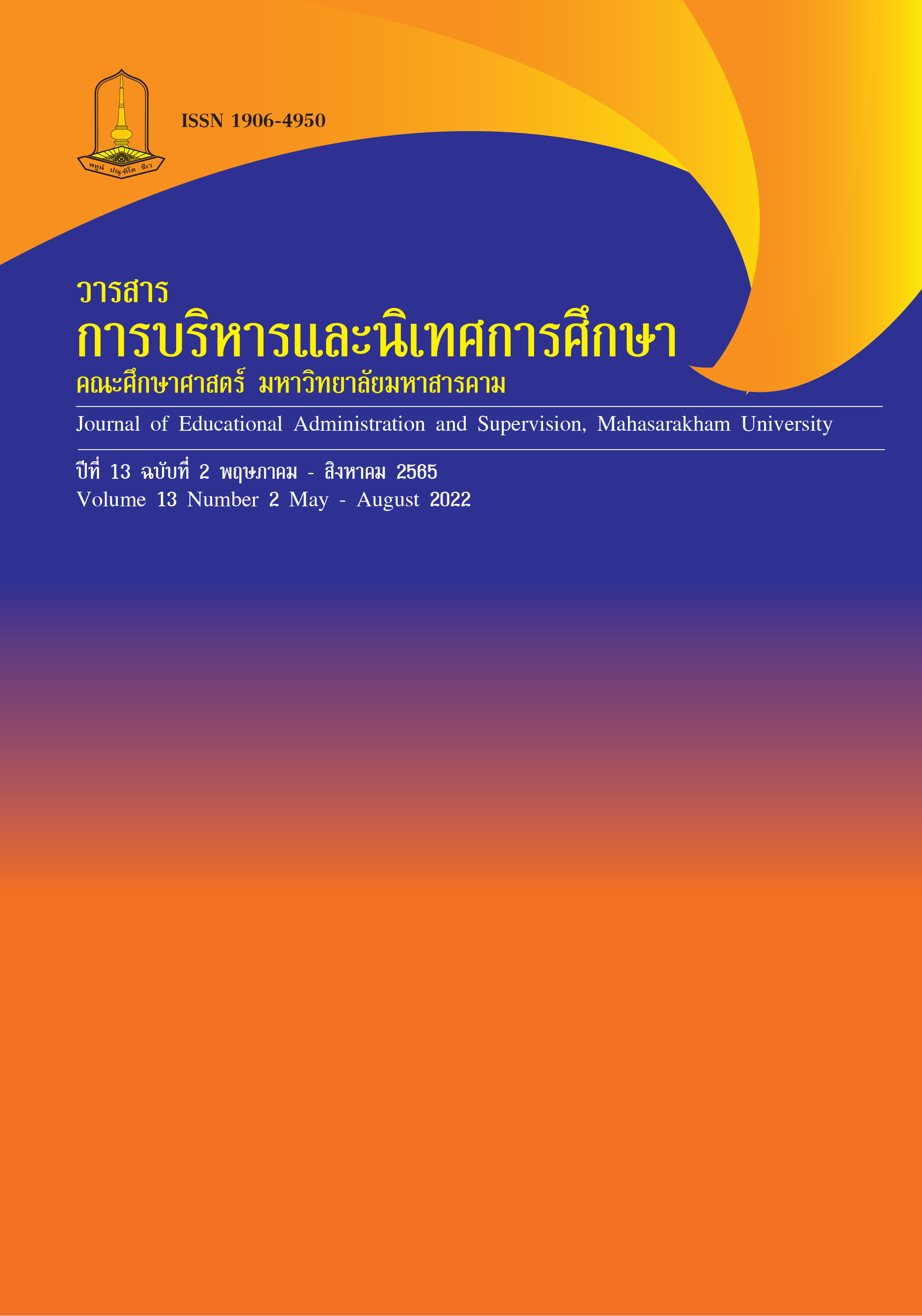Developing a Program to Strengthen Strategic Leadership of Secondary School Administrators Under the Secondary Educational Service Area Office Mahasarakham
Main Article Content
Abstract
This research aimed: 1) to explore existing situations, desirable situations, and needs to develop the strategic leadership of secondary school administrators under the secondary educational service area office mahasarakham; and 2) to develop the program to strengthen strategic leadership of secondary school administrators under the secondary educational service area office mahasarakham. Mixed methods research was employed. The research divided into two phases: The 1st phase was exploring the existing situations, desirable situations, and needs to develop the strategic leadership of secondary school administrators.
Data were collected from 314 samples of secondary school administrators and teachers under the secondary educational service area office mahasarakham through stratified random sampling technique; and the 2nd phase was developing a program to strengthen strategic leadership of secondary school administrators. The program was evaluated to find propriety and feasibility by 5 experts. The research instruments were existing and desirable situations questionnaire, interview form, and the program evaluation form. Statistics used in analyzing data were mean, standard deviation, and modified priority needs index. The research results were: 1) The existing situations of strategic leadership of secondary school administrators were at a low level, while the desirable situations were at a high level. Priority needs to develop from high to low were creating a vision, anticipating and creating a future, gathering multiple inputs to formulate strategy, revolutionary thinking, and high order of thinking and understanding respectively; and 2) The program to strengthen strategic leadership of secondary school administrators under the secondary educational service area office mahasarakham comprising 1) Rationale; 2) Objective; 3) content consists of 5 modules; Module 1 high order of thinking and understanding, Module 2 gathering multiple inputs to formulate strategy, Module 3 revolutionary thinking, Module 4
anticipating and creating a future, and Module 5 creating a vision; 4) methods and activities of development consists of creating awareness, develop understanding and knowledge, and on the job learning development; and 5) assessment. The program evaluation to find propriety and feasibility was at the highest level.
Downloads
Article Details
References
กระทรวงศึกษาธิการ. (2560). ระบบสารสนเทศเพื่อการบริหารการศึกษา. กรุงเทพฯ: อมรินทร์พริ้นติ้ง แอนด์พับลิชชิ่ง.
กล้าศักดิ์ จิตต์สงวน, ปิยพงษ์ สุเมตติกุล และไพฑูรย์ สินลารัตน์. (2557). รูปแบบการพัฒนาภาวะผู้นำเชิงกลยุทธ์สำหรับผู้บริหารโรงเรียนระดับมัธยมศึกษา. วารสารวิชาการ มหาวิทยาลัยอีสเทิร์นเอเชีย, 4(1), 201-211.
จรูญรัตน์ วัฒนศักดิ์ศิริ (2561). การพัฒนาภาวะผู้นำเชิงกลยุทธ์ของหัวหน้าสาขาวิชาในมหาวิทยาลัยเทคโนโลยีราชมงคล. วิทยานิพนธ์ปริญญาการศึกษาดุษฎีบัณฑิต สาขาวิชาการบริหารและพัฒนาการศึกษา คณะศึกษาศาสตร์ มหาวิทยาลัยมหาสารคาม.
ตะวัน สื่อกระแสร์. (2556). ยุทธศาสตร์การบริหารจัดการโรงเรียนเอกชนสู่ความเป็นเลิศ. วารสารมนุษยศาสตร์สังคมศาสตร์และวิทยาศาสตร์, 6(3), กันยายน- ธันวาคม.
ธานินทร์ เอื้ออภิธร. (2560). มนุษย์จะสร้างทักษะการเรียนรู้ใหม่เพื่อรับมือความเปลี่ยนแปลงในอนาคตอย่างไร. แหล่งสืบค้น ttps://thestandard.co/author/thanin/ สืบค้นเมื่อ 18 สิงหาคม 2564.
ธีรศักดิ์ ชนะบางแก้ว. (2557). ภาวะผู้นำ. แหล่งสืบค้น: http://baanjomyut.com. สืบค้นเมื่อ 19 สิงหาคม 2564.
พิพัฒน์ นนทนาธรณ์. (2561). ภาวะผู้นำเชิงกลยุทธ์: การแปลงวิสัยทัศน์สู่ความเป็นจริง. กรุงเทพฯ: ศูนย์ผู้นำธุรกิจเพื่อสังคมแห่งมหาวิทยาลัยเกษตรศาสตร์.
พิมพ์พิศา ชัชชวพันธ์. (2559). การพัฒนาโปรแกรมเสริมสร้างภาวะผู้นำเชิงกลยุทธ์ของผู้บริหารโรงเรียนมัธยมศึกษา. วิทยานิพนธ์ปริญญาการศึกษาดุษฎีบัณฑิต สาขาวิชาการบริหารและพัฒนาการศึกษา คณะศึกษาศาสตร์ มหาวิทยาลัยมหาสารคาม.
รังสรรค์ ประเสริฐศรี. (2551). ภาวะผู้นำ (พิมพ์ครั้งที่ 2). กรุงเทพฯ: ธีระฟิลม์ และไซเท็กซ์.
สุวิมล ว่องวาณิช. (2559). การวิจัยประเมินความต้องการจำเป็น. พิมพ์ครั้งที่ 3. กรงุเทพฯ: สำนักพิมพ์แห่งจุฬาลงกรณ์มหาวิทยาลัย.
Betty, A. (2005). Lesson in Strategic Leadership for Service. Nurse Leader, 3(5), 25-35.
Dubrin, J.A. (2004). Leadership: Research Finding: Practice and Skills. Boston: Houghton Mifflin Company.
Dubrin, J.A. (2010). The Principles of Leadership. 6th ed. Toronto: Houghton Mifflin Company.
Giles, S. (2017). How VUCA is Reshaping the Business Environment, and What it Means for Innovation. Retrieved from: https://www.forbes.com, 20 May 2021.
Ireland, R.D. & Hitt, M.A. (1999). Achieving and Maintaining Strategic Competitiveness in the Twenty-first Century: The Role of Strategic Leadership. Academy of Management Executive, 13(1), 43-47.
Ivancevich, J.M., and Matterson, T.M. (2008). Organization Behavior and Management. 6th ed. Houston: McGraw–Hill.
Krejcie, R. V. & Morgan, D. W. (1970). Determining Sample Size for Research Activities. Educational and Psychological Measurement, 30(3), 607-610.
Lombardo, M.M., and Eichinger, R.W. (1996). Career-architect Development Planner. Minneapolis, MN: Lominger
Maria E.M. (2011). Leadership theory and educational outcomes: The case of distributed and transformational leadership. Retrieved from: http://www.icsei.net/icsei2011/Full%20Papers/0125.pdf, 20 August 2021.
Rabin, R. (2013). Blended Learning for Leadership: The CCL Approach. Retrieved December 31, 2014, from http://www.ccl.org/Leadership/pdf/research/ BlendedLearning Leadership.pdf
Reinhold, D., Patterson, T., and Hegel, P. (2015). Make Learning Stick: Best Practices to Get the Most Out of Leadership Development. Retrieved from Center for Creative Leadership website: http://media.ccl.org/wp-content/uploads/2015/02/MakeLearningStick.pdf.


